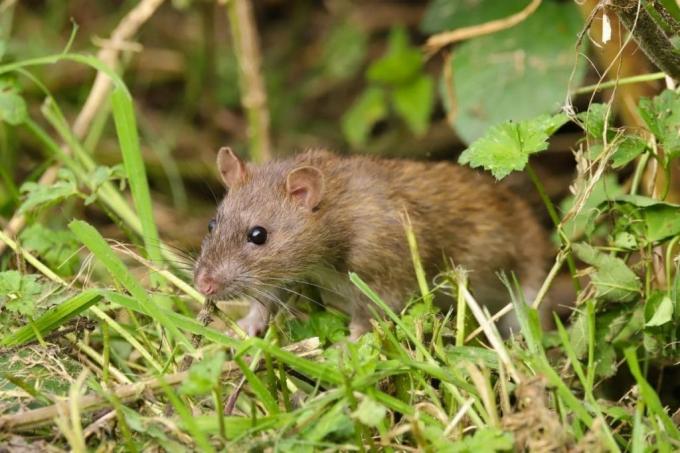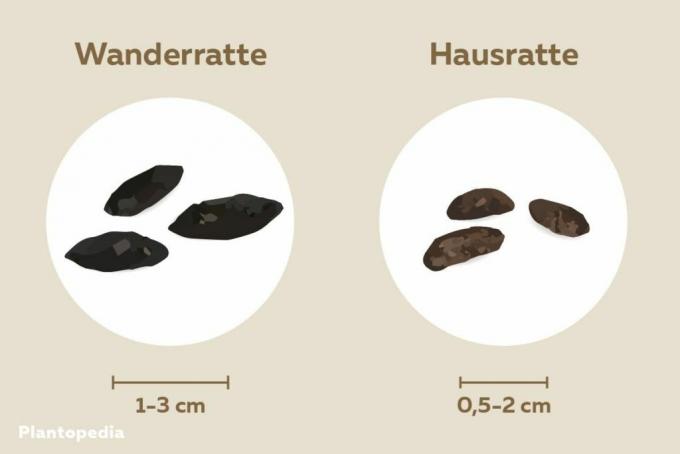
table of contents
- Recognize brown rats
- Recognize brown rat droppings - what does it look like?
- Dangers of brown rat droppings
- Elimination of brown rat droppings and odor
- frequently asked Questions
Brown rats are one of the most common rat species in Europe. If you suspect that the rodents have also taken up residence in your area, rat droppings are the most striking evidence of an infestation. We'll tell you here how to recognize brown rat droppings.
In a nutshell
- Brown rat droppings as a health risk
- 1 - 3 cm long, spindle-shaped feces
- Feces accumulated in groups
- Elimination possible in compliance with protective measures
Recognize brown rats
Brown rats (rattus norvegicus) are the original form of today's laboratory and house rats (rattus rattus). You can recognize them by the following features:
- brown to gray fur
- Length: 19 - 30 cm (head-torso)
- Tail length: 13-32 cm tail length
- Weight: up to 500 g
This means that they are overall slightly larger than their relatives, but have a shorter tail, smaller ears and a less pointed snout. Brown rats need access to water and therefore prefer to live in moist habitats such as sewers, streams or damp holes in the ground. Due to the destruction of their natural habitats, however, they are increasingly being pushed into the territory of the house rats and thus into the domestic environment.

Recognize brown rat droppings - what does it look like?
If you find feces in your home, it is worth taking a closer look to identify the animal. In particular, it is important to differentiate between brown rats and house rats. House rats are considered an endangered species and are under special protection. Brown rats, on the other hand, can, if gentler methods remain unsuccessful, can also be eliminated with a snap trap as a last resort. To correctly identify brown rat droppings, take a look at our table:
| Brown rat droppings | House rat droppings |
| tapering spindle-shaped (see. Rice grain) |
banana-shaped |
| 1 - 3 cm long | 0.5 - 2 cm long |
| rather broad and thick | rather long and thin |
| lies together in groups | widely scattered in the house |
| black | dark brown |
| irregular | evenly |

Brown rats leave their excrement in the entire area, but contact is very likely, especially in basement rooms. There is a special need for action if the droppings are still fresh or if you find rat droppings of different sizes, because this indicates an increase in the population. Consult the health department or a pest controller.
tip: Dried manure can be pierced with a wooden stick, while fresh manure is soft, shiny and dark and sticks to the wood.
Dangers of brown rat droppings
When finding feces, one should not panic at first. It's entirely possible that a rat just made its way through your home. Nevertheless, caution should be exercised: the faeces of the animals transmit more than 100 diseases, among others
- Typhus
- rabies
- tuberculosis
- cholera
- Hantavirus
- Animal diseases like swine fever
Rat droppings contaminate food and feed and pose a threat to humans. For this reason, there is already an urgent suspicion of rats, according to the regulatory authority ordinance on rat control.
Elimination of brown rat droppings and odor
If you have identified rat excrement in your area, it is therefore important to remove it as soon as possible. Due to the high risk of infection, the removal goes far beyond conventional cleaning, as you can see from our instructions:
- extensive ventilation of the room
- Put on a protective mask and hygienic gloves
- Removal of excrement and small excrement with a broom and shovel
- Dispose of the waste in a well sealed garbage bag
- Allow hot water with all-purpose cleaner to act on the affected area of the floor for 20 minutes
- Wipe and disinfect the floor
- renewed cleaning with water and all-purpose cleaner
- use chlorine bleach to neutralize odors
- Thoroughly clean used equipment
In a modified form, the list also applies to the removal of brown rat droppings from other surfaces. In the garden, the manure can simply be gouged out and removed with a spade.

Note: During removal, the feces should never come into contact with the skin or fecal particles should be inhaled, as diseases can be transmitted in this way.
frequently asked Questions
As inhaling the feces can lead to an infection with the dangerous hantavirus, a doctor should be consulted urgently. This can treat any symptoms well.
Yes, even after drying, brown rat droppings can still transmit diseases and should therefore always be disposed of in compliance with protective measures.
Yes, just like humans, animals can also be at risk. Dogs in particular have a tendency to eat faeces lying around. If you suspect your pet has eaten infected feces, see a veterinarian. In case of suspicion, it is advisable to bring a sample of the excrement in a small bag.
Rats are attracted by food. Therefore, never flush food down the toilet or leave it open. A clean environment and, if necessary, the installation of backflow flaps are also helpful



